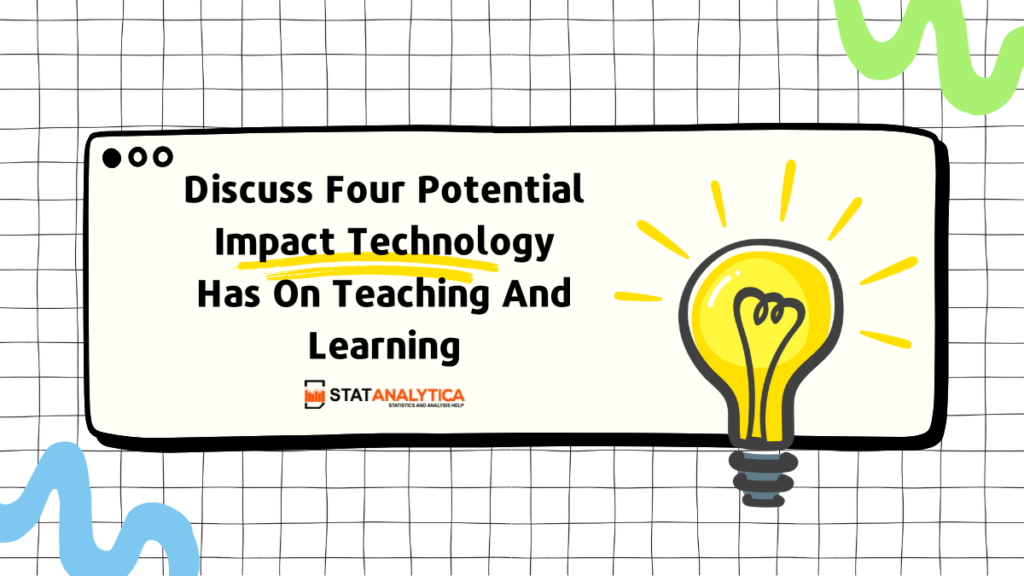Today, technology is a big part of nearly everything we do in our daily lives. From how we communicate to how we work and learn, technology is everywhere. One of the most significant areas where technology has made a major impact is education. In this blog, we’ll discuss four potential impact technology has on teaching and learning, and why these changes matter.

What Is The Impact Of Technology?
Table of Contents
The impact of technology on various aspects of life is profound and multifaceted. Here are some key areas where technology has made significant changes:
Communication
- Speed and Efficiency: Technology has revolutionized how we communicate, making it faster and more efficient through emails, instant messaging, and video calls.
- Global Connectivity: Social media platforms and communication apps connect people globally, making it easier to stay in touch with friends, family, and colleagues worldwide.
Education
- Enhanced Accessibility: Online courses and educational resources make learning accessible to a wider audience, including those in remote areas or with disabilities.
- Personalized Learning: Adaptive learning technologies tailor educational experiences to individual student needs, improving engagement and outcomes.
- Engagement: Interactive tools and multimedia content make learning more engaging and enjoyable.
Healthcare
- Telemedicine: Technology enables remote consultations and monitoring, improving access to healthcare services.
- Medical Advancements: Innovations in medical technology, such as MRI machines and robotic surgery, enhance diagnostic and treatment capabilities.
Business and Economy
- Automation: Technology automates repetitive tasks, increasing efficiency and productivity.
- E-Commerce: Online shopping platforms have transformed retail, providing convenience and a wider range of products.
- Remote Work: Technology facilitates remote work, offering flexibility and reducing the need for physical office spaces.
Entertainment
- Streaming Services: Technology has revolutionized how we consume entertainment through streaming services, providing on-demand access to movies, music, and shows.
- Gaming: Advances in gaming technology have created immersive experiences with high-quality graphics and interactive gameplay.
Social Interaction
- Social Media: Platforms like Facebook, Twitter, and Instagram enable people to share their lives and stay connected with others.
- Online Communities: Technology fosters the creation of online communities where people with shared interests can connect and interact.
Environment
- Sustainability: Technology aids in environmental conservation through innovations like renewable energy sources and smart grids.
- Monitoring: Advanced sensors and data analytics help monitor environmental changes and address issues like climate change and pollution.
Transportation
- Smart Transportation: GPS technology and ride-sharing apps improve navigation and reduce travel time.
- Electric Vehicles: Advances in battery technology and electric vehicles promote sustainable transportation solutions.
Daily Life
- Convenience: Smart home devices automate household tasks, increasing convenience and efficiency in daily life.
- Access to Information: The internet provides instant access to a vast amount of information, enhancing knowledge and decision-making.
Security
- Cybersecurity: Technology is critical in protecting data and maintaining privacy in the digital age.
- Surveillance: Advances in surveillance technology improve security and crime prevention.
Discuss Four Potential Impact Technology Has On Teaching And Learning
1. Enhanced Accessibility and Inclusion
Learning Tools for Students with Disabilities
One of the greatest benefits of technology in education is that it makes learning accessible to everyone, including students with disabilities. There are many tools and software designed to help students who might have difficulty learning in a traditional classroom.
For example, screen readers help students who are visually impaired by reading text out loud. There are also speech-to-text programs that help students who have difficulty writing by converting their spoken words into written text.
These tools make it easier for all students to participate and succeed in their education.
Online Resources and Courses
Technology also makes education accessible to people who might not be able to attend traditional schools. Online resources and courses are available to anyone with an internet connection. This means that students can learn from the best teachers and access high-quality educational materials no matter where they live.
For example, a student in a remote area can take a course from a top university online, something that wouldn’t have been possible before the advent of online education.
Bridging Geographical and Socio-economic Gaps
Moreover, technology helps bridge the gaps caused by geographical and socio-economic barriers. Students from different parts of the world can now learn together and share their experiences.
Educational apps and online platforms often offer free or low-cost access to high-quality learning materials, helping students from less privileged backgrounds get the education they need.
This leveling of the playing field means that more students have the opportunity to achieve their educational goals.
2. Personalized Learning
Adaptive Learning Software and Platforms
Another significant impact of technology on education is personalized learning. With the help of adaptive learning software and platforms, education can be tailored to meet the individual needs of each student. These programs analyze how a student learns and adjust the content and pace accordingly.
For example, if a student is struggling with a particular concept, the software can provide additional resources and practice problems to help them understand better.
On the other hand, if a student is excelling, the program can introduce more challenging material to keep them engaged.
Tailored Educational Experiences
Personalized learning means that each student can have a unique educational experience. Traditional classrooms often have to move at a set pace, which can be too fast for some students and too slow for others.
With technology, students can learn at their own pace, spending more time on subjects they find difficult and moving quickly through those they find easy.
This tailored approach helps students understand and retain information better, leading to a more effective learning experience.
Data-Driven Insights for Teachers
Teachers also benefit from personalized learning technology. These tools provide data-driven insights that help teachers understand how each student is performing.
Teachers can see which students need more help and which are ready for more advanced material. This information allows teachers to tailor their instruction to meet the needs of their students, making their teaching more effective and improving student outcomes.
3. Increased Engagement and Motivation
Interactive and Multimedia Content
Technology also makes learning more engaging and motivating for students. Interactive and multimedia content, such as videos, animations, and simulations, can make complex concepts easier to understand and more interesting.
For example, a biology student can watch a video showing how cells divide, or a physics student can use a simulation to see how different forces affect the motion of an object.
These engaging materials help capture students’ attention and make learning more enjoyable.
Gamification in Educational Activities
Another way technology increases engagement is through gamification. Gamification means using game elements, like points, levels, and rewards, in non-game contexts, such as education.
Educational games and activities make learning fun and motivating.
For example, a math app might turn solving problems into a game where students earn points for correct answers and can level up as they progress.
This approach makes learning feel like play, which can motivate students to spend more time on their studies and improve their skills.
Real-Time Feedback and Assessments
Technology also provides real-time feedback and assessments, which help keep students motivated. In traditional classrooms, students often have to wait days or even weeks to get feedback on their work.
With technology, they can get immediate feedback, helping them understand what they did right and where they need to improve.
For example, an online quiz can show students their results as soon as they finish, and adaptive learning software can provide instant feedback on assignments. Getting immediate feedback helps students stay interested and motivated to continue learning.
4. Collaboration and Communication
Online Collaboration Tools
Technology has also transformed how students collaborate and communicate. Online tools like Google Classroom and Microsoft Teams let students work together on projects and assignments from anywhere.
These tools make it easy to share documents, discuss ideas, and give feedback, promoting teamwork and collaboration.
For example, students can work together on a presentation by simultaneously editing a shared document, or they can hold a virtual meeting to discuss their project.
Virtual Classrooms and Discussion Forums
Virtual classrooms and discussion forums also enhance communication and collaboration among students and teachers. In a virtual classroom, students can attend live classes from anywhere in the world, participating in discussions and asking questions in real-time.
Discussion forums provide a space for students to continue the conversation outside of class, sharing ideas and helping each other with problems.
These platforms make learning more interactive and collaborative, allowing students to learn from each other as well as from their teachers.
Global Connections and Cultural Exchange Opportunities
Finally, technology opens up opportunities for global connections and cultural exchange. Students can connect with their peers from different countries, learning about different cultures and perspectives.
This global interaction broadens their horizons and helps them develop a better understanding of the world.
For example, a history class might have a virtual exchange with students from another country to discuss different perspectives on a historical event
Conclusion
In conclusion (discuss four potential impact technology has on teaching and learning), technology has a profound impact on teaching and learning, making education more accessible, personalized, engaging, and collaborative. It provides tools for students with disabilities, offers online resources and courses, and bridges geographical and socio-economic gaps.
Technology also enables personalized learning, with adaptive software and data-driven insights that help tailor educational experiences to individual needs. It increases engagement and motivation through interactive content, gamification, and real-time feedback.
Finally, technology enhances collaboration and communication with online tools, virtual classrooms, and global connections.
As technology continues to evolve, its role in education will likely grow even more significant. Educators and students must embrace these changes and harness the power of technology to create better learning experiences.
By doing so, we can ensure that education is accessible to all, tailored to individual needs, engaging, and collaborative, preparing students for success in the digital age.


